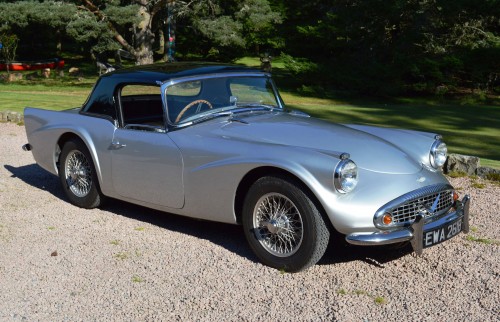
Click Here for Full Screen Image - Click Here to Download Image
 |  |  |  |  | |||||
 |  |  |  |  |
| Lot number | 88 |
|---|---|
| Hammer value | £32,500 |
| Description | Daimler Dart SP250 Manual |
| Year | 1964 |
| Colour | Silver |
| Engine size | 2,548 cc |
| Chassis No. | 104378 |
| Engine No. | 97622 |
One of the oldest and most aristocratic names in motoring history, Daimler was long famed for producing a string of worthy but unremarkable cars aimed at satisfying the conservative tastes of the upper-middle-class motorist.
How extraordinary, then, that they should suddenly spring one of the most outlandish sportscars ever to grace the highway onto an unsuspecting public. Aimed squarely at the American market, the Daimler Dart was launched at the 1959 New York Motor Show but was soon renamed the SP250 after Chrysler asserted that they had already trademarked the Dart name for a forthcoming Dodge.
It featured a truly wacky glassfibre body that combined a bewildering assortment of curves and fins with a face that came straight from a grouper fish. Love it or hate it, you certainly can’t ignore it.
Built on a traditional cruciform-braced ladder-frame chassis equipped with independent coil-and-wishbone front suspension and a leaf-sprung \\\\\\\\\\\\\\\'live\\\\\\\\\\\\\\\' rear axle, it had modern disc brakes all round and a four-speed manual gearbox with synchromesh on the top three speeds. But what really grabbed the attention of anyone who drove it was the magnificent V8 engine. Designed by Edward Turner, this 2.5-litre ‘hemi’ is one of the most charismatic engines ever made, a lightweight marvel of unparalleled refinement and flexibility that also emits a fabulously fruity exhaust note.
Producing 140bhp and 155lb/ft of torque, it could throw the Dart to 60 in 8.2 seconds on its way to a top speed of 125mph, but was flexible enough to burble around town in top. No wonder it proved an immediate hit with the police who ordered a small fleet as high-speed pursuit vehicles, all painted black. Drag racers also loved the engine and it became a favourite on the strip where the top fuel boys ultimately managed to extract well over 1,000bhp from this heroic V8.
In initial ‘A’ series form the car was criticized for an over-flexible chassis and when Jaguar took over Daimler in 1960, they promptly brought out a ‘B’ spec version with a much-stiffened frame, thicker bodywork and other detail improvements. In 1963 the car was improved still further as the ‘C’ series, featuring more sumptuous trim and luxuries such as a heater.
Production finally came to an end in 1964 by which time just 2,645 examples had been sold, the vast majority in America. Survivors are now surprisingly rare, good ones having shot up in value recently.
First registered on 4 April 1964, this late ‘C’ spec car is one of the last built. Painted in silver with a black works hard-top it was ordered with wire wheels and a rare wood-rim factory supplied steering wheel. In place of the standard rear bench seat, a single transverse rear seat was fitted at the factory and this example is believed to be one of just three cars so equipped, one being purchased by Princess Margaret and the other exported to Canada.
The vendor, who is just its third owner, purchased the car in 1978 from the head salesman at Central Motors in Sheffield. He had bought it back from its original owner (a well known Sheffield decorator) 11 years previously having sold the car to him new in 1964.
Meticulously cared for all its life, it has only covered 46,000 miles from new. In 1991 it underwent a comprehensive refurbishment which included a complete engine out respray. A new clutch was fitted along with all new brake and fuel pipes, discs and pads and new shock absorbers.
In 2005 all of the wheels were rebuilt and epoxy powder coated and fitted with the correct Michelin XAS tyres. A stainless steel exhaust was also fitted which sounds fabulous. The original black leather upholstery remains in lovely condition and the hood and tonneau covers (x2) are also described as in good condition having been little used. The front bumper and overriders were replated and a new windscreen fitted.
A well known entrant in a number of Daimler Club concours events over the years, it has scooped many awards including its most recent at the Anstruther weekend in 2008, its condition remaining just as good today as it has only covered 1,000 miles since.
The substantial history file includes no fewer than 32 old MOTs confirming the mileage back to 1978 at which time it had covered 37,036 miles. It is currently MOTd until September 2015. A substantial number of accumulated parts accompany the car, too numerous to list here, but including an original workshop manual and parts book, new brake components, rubber body seals, carburettor parts, new tripod headlamp inners, a spare windscreen and its original steering wheel which has remained with the car from new.
This lovely, original and well known example, with its rare sideways rear seat, is as fine an example as we have seen. Cars like this are thin on the ground, retaining an original driving feel thanks to careful maintenance, low mileage and sympathetic restoration when required.
CATALOGUE AMENDENT: Please note that the car is MOTd until July 2015 and not September 2015 as catalogued above.